![]()
![]()
![]()
Use LEFT and RIGHT arrow keys to navigate between flashcards;
Use UP and DOWN arrow keys to flip the card;
H to show hint;
A reads text to speech;
160 Cards in this Set
- Front
- Back
- 3rd side (hint)
|
Romanticism |
A cultural movement that surfaced in the second half of the 18th century and peaked in the first half of the 19th century. The movement was based on a belief in individual genius and originality and the expression of powerful emotions, as well as preference for exotic themes and the omnipotent force of nature, often viewed as a manifestation of God |
|
|
|
Planarity |
A term used to describe a composition where figures and objects are arranged parallel to the picture plane. |
|
|
|
Associationism |
A 20th century art historical term that refers to the concept that architecture and landscape design can have motifs or aspects that associate them with earlier architecture, art, history, or literature. |
|
|
|
Orientalism |
The fascination of Western culture, especially as expressed in art and literature, with Eastern cultures. In the 19th century, this fascination was especially focused on North Africa and the Near East, that is, the Arab world |
|
|
|
Pochades |
Small outdoor oil paintings made by landscape painters, serving as models for large-scale pictures that would be developed in the artist's studio. |
|
|
|
Albumen print |
A process in photography that uses the proteins found in eggs to produce a photographic plate. |
|
|
|
Avant garde |
Meaning "advance force" in French, the artists of the avant-garde in 19th and 20th century Europe lead the way in innovation in both subject matter and technique, rebelling against the established conventions of the art world. |
|
|
|
Sublime |
In 19th century art, the ideal and goal that art should inspire awe in a viewer and engender feelings of high religious, moral, ethical, and intellectual purpose. |
|
|
|
Neoclassicism |
An 18th century style that emphasizes classical themes, sometimes with strong moral overtones, executed in a way that places a strong emphasis on line, with figures and objects running parallel to the picture plane. Paintings and drawings are typically executed with sharp clarity, by way of tight handling of paint and clearly defined line and light. |
|
|
|
Plein-air |
Sketching outdoors, often using paints, in order to capture the immediate effects of light on landscape and other subjects. Much encouraged by the Impressionists their plein-air sketches were often taken back to the studio to produce finished paintings, but many plein-air sketches are considered masterworks. |
|
|
|
Gothic |
The style of art developed in France during the 12th century that spread throughout Europe. The style is characterized by daring architectural achievements, for example, the opening up of wall surfaces and the reaching of great heights, particularly in Cathedral construction. Pointed arches and ribbed groin vaults allow for a lightness of construction that permits maximum light to enter buildings through stained glass windows. Increasing naturalism and elegance characterize gothic sculpture and painting. |
|
|
|
Daguerreotype |
Originally, a photograph on a silver plated sheet of copper, which had been treated with fumes of iodine to form silver iodide on its surface and then after exposure developed by fumes of mercury. The process, invented by L. J. M. Daguerre and made public in 1839, was modified and accelerated as daguerreotypes gained popularity. |
|
|
|
Monotype |
A unique print made from a copper plate or other type of plate from which no other copies of the artwork are made. |
|
|
|
Scientific realism |
Thomas Eakins (1844-1916), the Philadelphian, was among the earliest and most powerful realist painters in America. He brought a scientific approach to his realism. His paintings are grounded in intense scientific inquiry designed to ensure the accuracy of his realism. He made numerous perspective studies and studied light effects and anatomy. As a teacher at the Pennsylvania Academy of Art, he had his students work from the nude model, rather than imitate plaster cast of classical figures. Realism in America. |
|
|
|
Empire style |
Interior design style developed for Napoleon's residences. The style is opulent using exotic materials and a saturated palette. One of the finest examples is the state bedroom that the architects Charles Percier and Pierre Francois Fontaine designed for Josephine Bonaparte. |
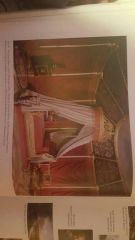
|
|
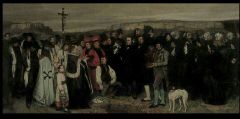
|
Gustave Courbet. Burial at Ornans. 1849-50. Realism. Oil on canvas |
|
|
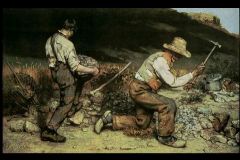
|
Gustave Courbet. The Stone Breakers. 1849. Realism. Oil on canvas |
|
|
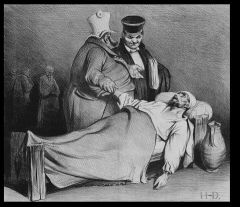
|
Honore Daumier. It's Safe to Release This One! 1834. Realism. Lithograph. |
|
|
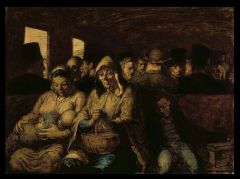
|
Honore Daumier. The Third Class Carriage. ca 1863-65. Realism. Oil on canvas |
|
|
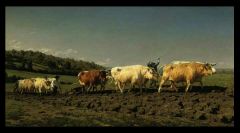
|
Rosa Bonheur. Plowing in the Nivernais: The Dressing of Vines. 1849. Realism. Oil on canvas |
|
|
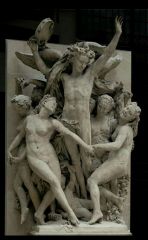
|
Jean-Baptiste Carpeaux. The Dance. 1867-69. Naturalism. Plaster. |
|
|
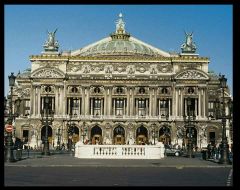
|
Charles Garnier. The Opera, Paris. 1861-74 |
|
|
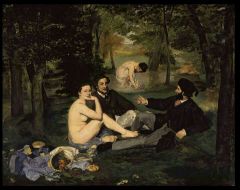
|
Edouard Manet. The Luncheon on the Grass (Le Dejeuner Sur l'Herbe). 1863. Realism. Oil on canvas |
|
|
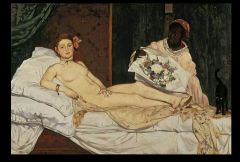
|
Edouard Manet. Olympia. 1863. Realism. Oil on canvas |
|
|
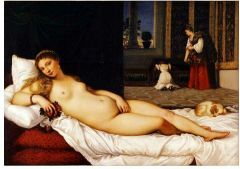
|
Titian. Venus of Urbino. 1538 |
|
|
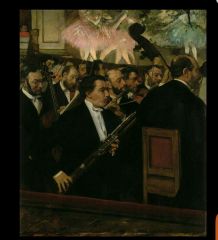
|
Edgar Degas. The Orchestra of the Paris Opera. 1868-69. Realism. Oil on canvas |
|
|
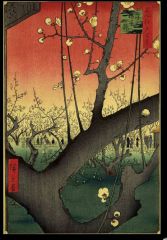
|
Ando Hiroshige. Plum Estate, Kameido, from the series One Hundred Famous Views of Edo. 1857. Japonisme. Woodblock print. |
|
|
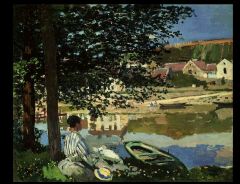
|
Claude Monet. On the Bank of the Seine, Bennecourt. 1868. Impressionism. Oil on canvas |
|
|
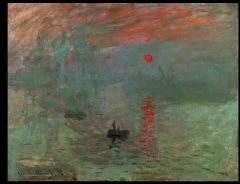
|
Claude Monet. Impression, Sunrise. 1872. Impressionism. Oil on canvas |
|
|
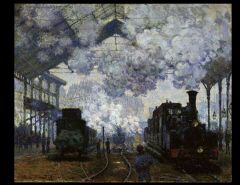
|
Claude Monet. The Gare Saint Lazare: Arrival of a Train. 1877. Impressionism. Oil on canvas |
|
|

|
Auguste Renoir. Luncheon of the Boating Party. 1881. Impressionism. Oil on canvas |
|
|
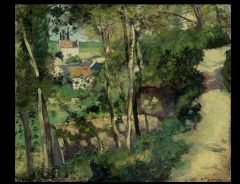
|
Camille Pissarro. Climbing Path, L'Hermitage, Pontoise. 1875. Impressionism. Oil on canvas |
|
|
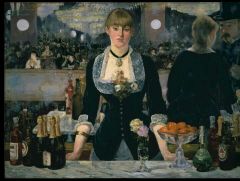
|
Edouard Manet. A Bar at the Folies-Bergere. 1881-82. Impressionism. Oil on canvas |
|
|
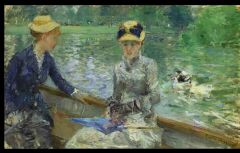
|
Berthe Morisot. Summer's Day (The Lake in the Bois de Boulogne). ca 1879. Impressionism. Oil on canvas |
|
|
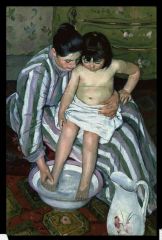
|
Mary Cassatt. The Child's Bath. 1891-92. Impressionism. Oil on canvas |
|
|
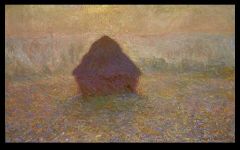
|
Claude Monet. Wheatstack, Sun in the Mist. 1891. Impressionism. Oil on canvas |
|
|
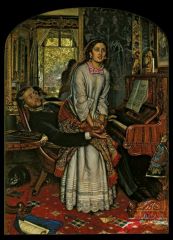
|
William Holman Hunt. The Awakening Conscience. 1853-54. Pre Raphaelite. Oil on canvas |
|
|

|
John Everett Millais. Christ in the Carpenter's Shop (Christ in the House of his Parents) 1849-50. Pre Raphaelite. Oil on canvas |
|
|
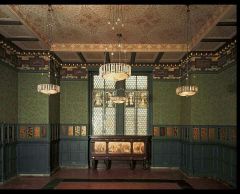
|
William Morris (Morris & Co.) Green Dining Room (William Morris Room) 1867. Pre Raphaelite |
|
|
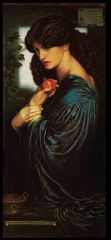
|
Dante Gabriel Rossetti. Proserpine. 1874. Post Pre Raphaelite. Oil on canvas |
|
|
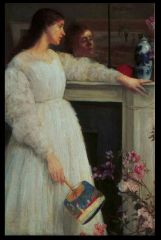
|
James Abbott McNeill Whistler. Symphony in White No. II : The little White Girl. 1864. Aestheticism. Oil on canvas |
|
|
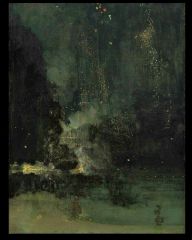
|
James Abbott McNeill Whistler. Nocturne in Black and Gold: The Falling Rocket. Ca 1875. Aestheticism. Oil on panel. |
|
|
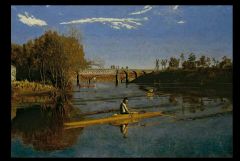
|
Thomas Eakins. Max Schmitt in a Single Scull (The Champion Single Sculls). 1871. Scientific realism. Oil on canvas |
|
|
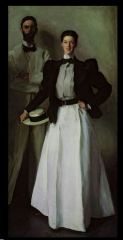
|
John Singer Sargent. Mr and Mrs I. N. Phelps Stokes. 1897. Realism. Oil on canvas |
|
|
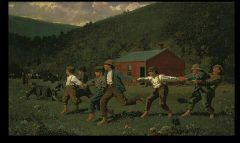
|
Winslow Homer. Snap the Whip. 1872. Realism. Oil on canvas |
|
|
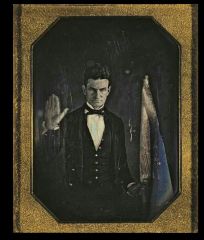
|
Augustus Washington. John Brown. Ca 1846-47. Photography. Quarter plate daguerreotype |
|
|
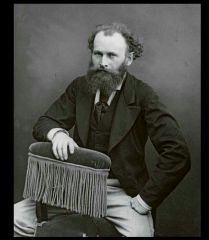
|
Nadar. Edouard Manet. 1870s. Photography. Albumen salted paper print mounted on Bristol board. |
|
|
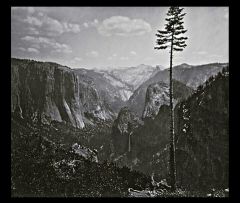
|
Carleton Watkins. Yosemite Valley from the Best General View. 1865-66. Photography. Albumen print |
|
|
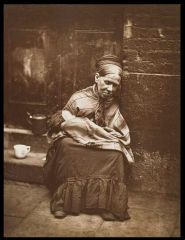
|
John Thomson. The Crawlers. 1877-78. Photography. Woodburytype |
|
|
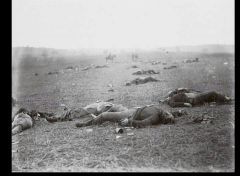
|
Timothy O'Sullivan. A Harvest of Death, Gettysburg, Pennsylvania July 1863, from Alexander Gardner's Gardner's Photographic Sketchbook of the War. 1866. Photography. Albumen print |
|
|
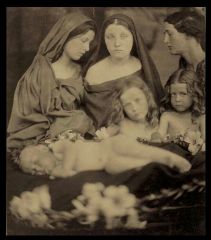
|
Julia Margaret Cameron. Sister Spirits. Ca 1865. Photography. Albumen print |
|
|
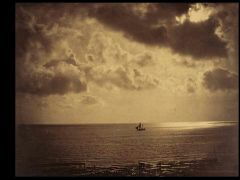
|
Gustave Le Gray. Brig on the Water. 1856. Photography. Albumen silver print from glass negative. |
|
|
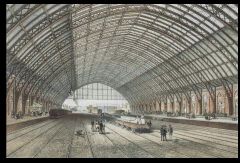
|
St. Pancras Station, London. 1863-76. Lithograph |
|
|
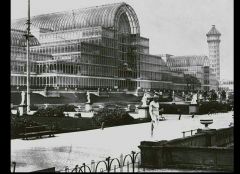
|
Probably by Phillip Henry Delamotte. The Crystal Palace at Sydenham, showing the main dome and entrance from the ornamental gardens and paths. (1820-89) |
|
|
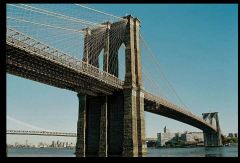
|
John and Washington Roebling. Brooklyn Bridge, New York. 1867-83 |
|
|
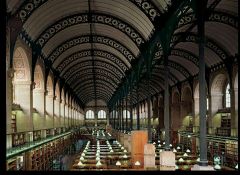
|
Henri Labrouste. Main reading room, Bibliotheque Saint-Genevieve, Paris. Designed 1842. Built 1842-51 |
|
|
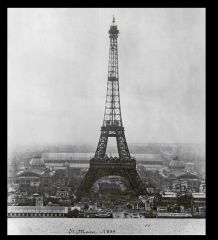
|
Gustave Eiffel. Eiffel Tower, Paris. 1887-89 |
|
|
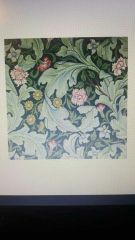
|
William Morris. Wall Paper Design. Late 1800s |
|
|
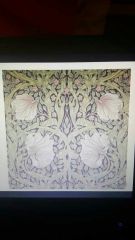
|
William Morris. Pimpernel. 1876 |
|
|
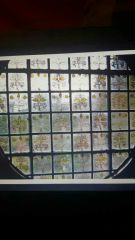
|
William Morris. Stained Glass in Red House. 1860 |
|
|
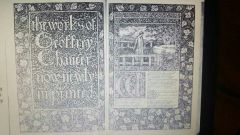
|
William Morris. Wood engraved illustrations after designs by Edward Burne Jones, folio from The Works of Geoffrey Chaucer. 1896 |
|
|
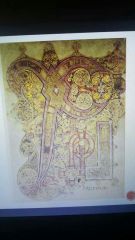
|
Chi Rho Page from the Book of Kells. C 800 |
|
|
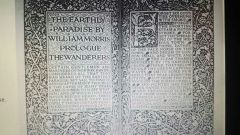
|
William Morris. Earthly Paradise. 1868 |
|
|
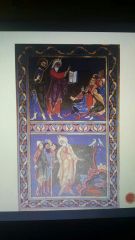
|
Illumination from the Bury Bible. 12th C |
|
|
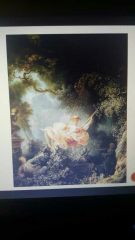
|
Fragonard. Happy Accidents of the Swing. 1767 |
|
|
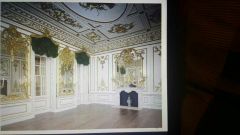
|
The Music Room from Norfolk House, St James's Square, London. 1748-1756 |
|
|
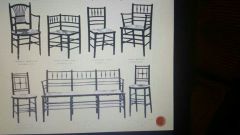
|
Morris and Co. Sussex Rush Seated Chairs. 1860s |
|
|
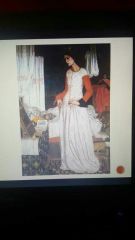
|
William Morris. Queen Guinevere. 1858 |
|
|
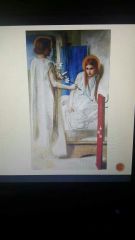
|
Dante Rossetti. Annunciation. 1850 |
|
|
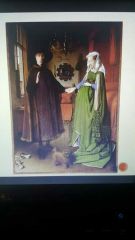
|
Jan Van Eyck. Arnolfini Portrait. 1434 |
|
|
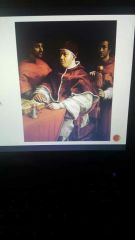
|
Raphael. Pope Leo X with Nephews. 1518 |
|
|
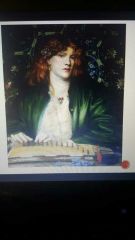
|
Rosetti. Blue Bower. 1865 |
|
|

|
Rosetti. Astarte Syriaca. 1877 |
|
|
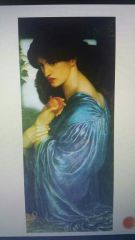
|
Rosetti. Persephone. 1873 |
|
|

|
Henry Van der Welde. Tropon Poster. 1899 |
|
|
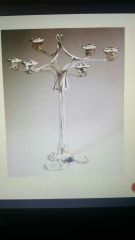
|
Henry Van der Welde. Candelabrum for 6 Candles. 1902 |
|
|
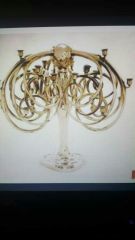
|
Gertraud von Schnellenbuhel. Candelabrum for 24 Candles. 1911 |
|
|
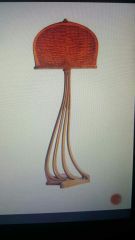
|
Alexandre Charpentier. Revolving Music Stand. 1900 |
|
|
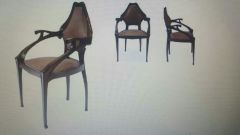
|
Bernard Pankok. Armchair. 1899 |
|
|
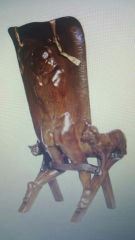
|
Rupert Carabin. Armchair. 1898 |
|
|
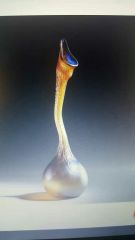
|
Tiffany. Glass Vase. C 1894 |
|
|
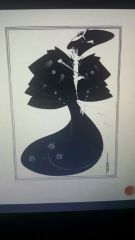
|
Aubrey Beardsley. The Black Cape. 1893. Symbolism. Pen drawing |
|
|
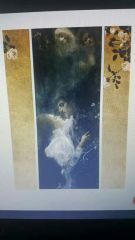
|
Gustave Klimt. Love. 1895. Symbolism. Oil on canvas |
|
|
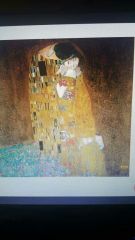
|
Gustave Klimt. The Kiss. 1907-08. Symbolism. Oil on canvas |
|
|
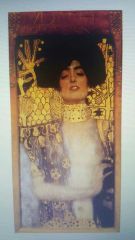
|
Gustave Klimt. Judith I. 1901. Symbolism. Oil on canvas |
|
|
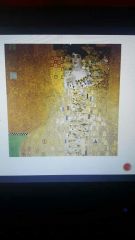
|
Gustave Klimt. Portrait of Adele Bloch-Bauer I. 1907. Symbolism. Oil on canvas |
|
|
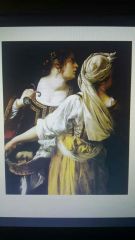
|
Artemesia Gentileschi. Judith and Maidservant with the Head of Holofernes. 1612 |
|
|
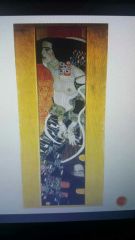
|
Gustave Klimt. Judith II. 1909. Symbolism. Oil on canvas |
|
|
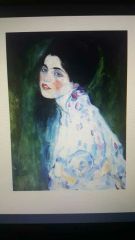
|
Gustave Klimt. Portrait of a Lady. C 1916. Symbolism. Oil on canvas |
|
|

|
Gustave Klimt. Emilie Floge. 1902. Symbolism. Oil on canvas |
|
|
|
Positivism |
The term used to describe the new mentality of pragmatism and materialism that emerged in the 1840s. The word was coined by the French philosopher Auguste Comte (1798-1857). Social progress should be based on observable fact and tested ideas or another words, on science not on feelings. This new scientific approach to studying society came to be called sociology. |
|
|
|
Pre-Raphaelite Brotherhood |
The secret society started in September 1848 by three students at the Royal Academy school. William Holman Hunt, John Everett Millais, and Dante Gabriel Rossetti, who was the leader and spokesperson. They denounced the art of the Royal Academy and most paintings since early Raphael. They found the work decadent in that it clouded truth and fact and placed a premium on such artificial formal qualities as elegant contours or pleasing compositional patterning. PRB. British realism. Part of art Nouveau Inspired by Renaissance masters and middle ages |
|
|
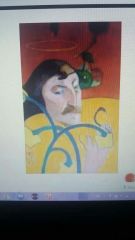
|
Paul Gauguin. Self Portrait. 1888. Post impressionism. Oil on canvas |
|
|
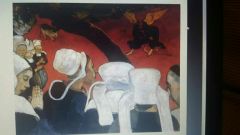
|
Paul Gauguin. The Vision After the Sermon (Jacob Wrestling with the Angel). 1888. Post impressionism. Oil on canvas. |
|
|

|
Paul Gauguin. The Yellow Christ. 1889. Post impressionism. Oil on canvas |
|
|

|
Paul Gauguin. Woman with a Mango. ND after 1891. Post impressionism. Oil on canvas |
|
|
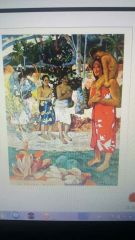
|
Paul Gauguin. La Orana Maria. 1891. Post impressionism. Oil on canvas. |
|
|
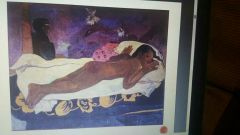
|
Paul Gauguin. The Spirit of the Dead Watching. 1892. Post impressionism. Oil on canvas |
|
|
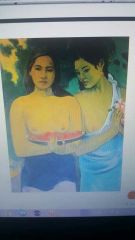
|
Paul Gauguin. Tahitian Women with Mango Blossoms. 1899 post impressionism. Oil on canvas |
|
|
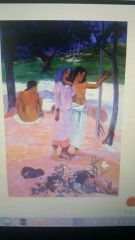
|
Paul Gauguin. The Call. 1902. Post impressionism. Oil on canvas |
|
|
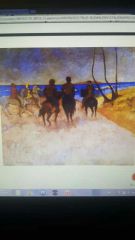
|
Paul Gauguin. Horsemen on the Beach. 1902. Post impressionism. Oil on canvas |
|
|
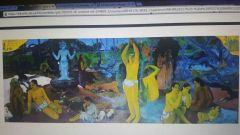
|
Paul Gauguin. Where Do We Come From? What Are We? Where Are We Going? 1897. Post impressionism. Oil on canvas |
|
|
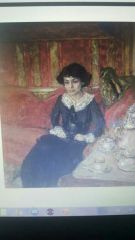
|
Edouard Vuillard. Girl in an Interior. C 1910. Post impressionism. Oil on board |
|
|
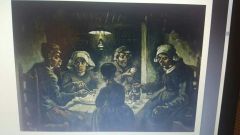
|
Vincent Van Gogh. The Potato Eaters. 1885. Post impressionism. Oil on canvas |
|
|
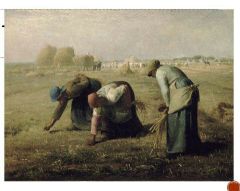
|
Jean-Francois Millet. The Gleaners. 1857. Realism. Oil on canvas |
|
|
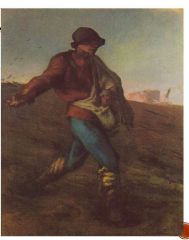
|
Jean-Francois Millet. The Sower. Ca 1850. Realism. Oil on canvas |
|
|
|
Salon de Refuse |
1863. Salon of the Refused. Louis Napoleon, Edouard Manet. Paintings rejected by salon jurors had their own show, but in a separate building |
|
|
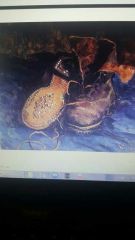
|
Vincent Van Gogh. A Pair of Boots. 1886-87. Post impressionism. Oil on canvas |
|
|

|
Vincent Van Gogh. Night Cafe. 1888. Post impressionism. Oil on canvas |
|
|
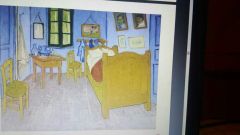
|
Vincent Van Gogh. Room at Arles. 1888. Post impressionism. Oil on canvas |
|
|
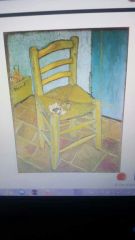
|
Vincent Van Gogh. Chair with pipe. 1889. Post impressionism. Oil on canvas |
|
|
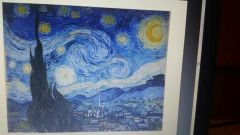
|
Vincent Van Gogh. Starry Night. 1889. Post impressionism. Oil on canvas |
|
|
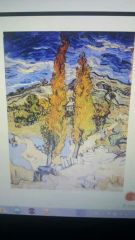
|
Vincent Van Gogh. Poplars on a Hill. ND. Post impressionism. Oil on canvas |
|
|
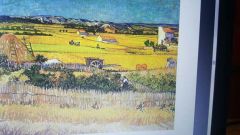
|
Vincent Van Gogh. Harvest at le Crau. 1888. Post impressionism. Oil on canvas |
|
|

|
Vincent Van Gogh. Peach Trees in Bloom. 1889. Post impressionism. Oil on canvas |
|
|
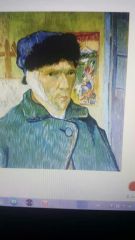
|
Vincent Van Gogh. Self Portrait with Ear Cut Off. 1889. Post impressionism. Oil on canvas |
|
|

|
Vincent Van Gogh. Self Portrait. 1889. Post impressionism. Oil on canvas |
|
|
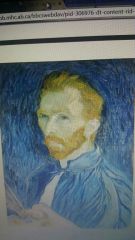
|
Vincent Van Gogh. Self Portrait. 1890. Post impressionism. Oil on canvas |
|
|
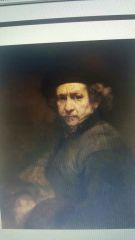
|
Rembrandt. Self Portrait. 1659. Realism. Oil on canvas |
|
|

|
Similarities: Face has colour, everything else dark Muted/subdued lighting Gaze is similar Differences: Gestural, exaggerated expressive vs realism (downplayed brush strokes) Dark background but still lots of colour vs less colour, softer |
|
|

|
Henri de Toulouse-Lautrec. A la Mie. 1891. Post impressionism. Oil on cardboard |
|
|
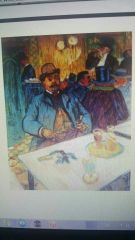
|
Henri de Toulouse-Lautrec. Monsieur Boileau at the Cafe. 1893. Post impressionism. Gouache |
|
|
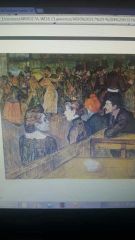
|
Henri de Toulouse-Lautrec. Moulin de la Galette. 1889. Post impressionism. Oil on canvas |
|
|
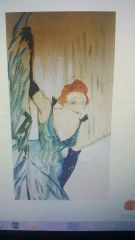
|
Henri de Toulouse-Lautrec. Yvette Guilbert Taking a Curtain Call. ND 1894. Post impressionism. Watercolor crayon oil and white heightening on tracing paper mounted on cardboard |
|
|
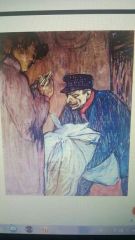
|
Henri de Toulouse-Lautrec. The Laundryman Calling at the Brothel. 1894. Post impressionism. Oil on cardboard |
|
|
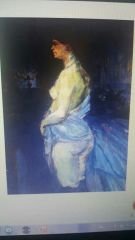
|
Henri de Toulouse-Lautrec. Woman Lifting Chemise. 1901. Post impressionism. Oil on wood panel |
|
|
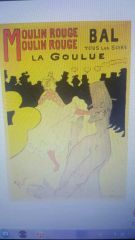
|
Henri de Toulouse-Lautrec. La Goulue. 1891. Post impressionism. Coloured lithographic poster. |
|
|
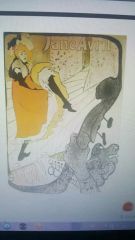
|
Henri de Toulouse-Lautrec. Jane Avril. 1893. Post impressionism. Lithograph printed in 5 colors, machine wove paper |
|
|
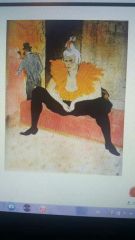
|
Henri de Toulouse-Lautrec. Seated Female Clown. 1896. Post impressionism. Colour lithograph |
|
|
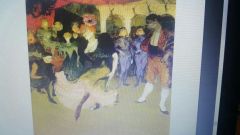
|
Henri de Toulouse-Lautrec. Portrait of Marcelle Lender, Marcelle Lender Dancing the Bolero in Chilperic. 1895-96. Post impressionism. Oil on canvas |
|
|
|
Pointillism |
Georges Seurat. Many dots of various colors that when seen from a distance blend together to create an image Divisionism |
|
|
|
Post Impressionism |
Seurat, Cezanne (composition). Gauguin, Van Gogh, Lautrec (expressive). No common goal, naturalism (working directly from nature), more vibrant colors, accepted 2D canvas, introduced careful consideration to compositions, incorporated more context/background story into work. Usually oil on canvas. |
|
|
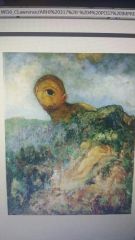
|
Odilon Redon. Cyclops. 1898. Post impressionism/escapism/symbolism. Oil on canvas |
|
|
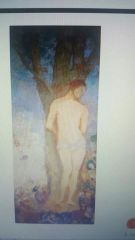
|
Odilon Redon. St Sebastian. 1900. Escapism. Oil? |
|
|

|
Odilon Redon. Haunting Closed Eyes. ND 1890. Escapism/post impressionism. Oil on canvas |
|
|

|
Edvard Munch. The Voice. 1893. Post impressionism. |
|
|

|
Edvard Munch. The Scream. 1893. Post impressionism/symbolism. Tempera and casein on cardboard |
|
|
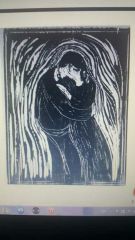
|
Edvard Munch. The Kiss. 1902. Post impressionism/symbolism . Woodcut |
|
|
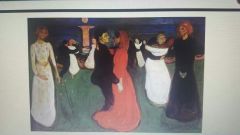
|
Edvard Munch. The Dance of Life. 1899-1900. Post impressionism/symbolism . Oil |
|
|
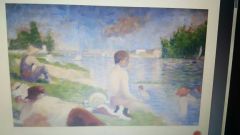
|
Georges Seurat. Bathers. 1884. Post impressionism. Oil on canvas |
|
|

|
Georges Seurat. Bathers. 1884. Post impressionism. Oil on canvas |
|
|
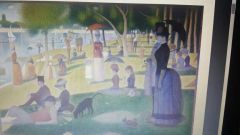
|
Georges Seurat. Sunday Afternoon on the Island of la Grande Jatte. 1884-1886. Post impressionism. Oil on canvas |
|
|
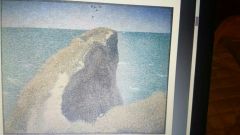
|
Georges Seurat. La Bec du hoc at Grandcamp. 1885. Post impressionism. Oil |
|
|
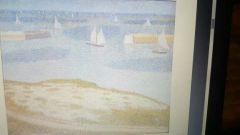
|
Georges Seurat. Fishing Fleet. 1888. Post impressionism. Oil on canvas |
|
|
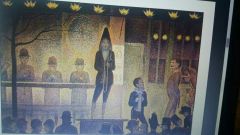
|
Georges Seurat. La Parade. 1887-89. Post impressionism. Oil on canvas |
|
|
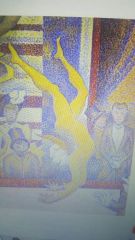
|
Georges Seurat. Circus. 1891. Post impressionism. Oil on canvas |
|
|
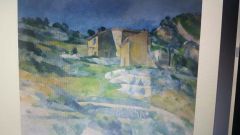
|
Paul Cezanne. Houses in Provence. 1880. Post impressionism. Oil on canvas |
|
|
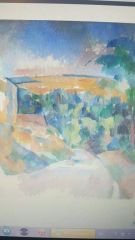
|
Paul Cezanne. Bend in the Road at Montgeroult. 1899. Post impressionism. Oil on canvas |
|
|
|
Nabis |
Secret organization founded in 1888 by young parisian artists, including Edouard Vuillard and Pierre Bonnard, who were stunned by the novelty and spirituality of Paul Gauguin's paintings. Nabi is Hebrew for prophet. |
|
|
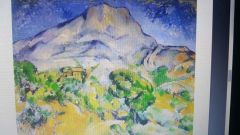
|
Paul Cezanne. Mount Saint Victoire above Tholonet Road. 1896-98. Post impressionism. Oil on canvas |
|
|
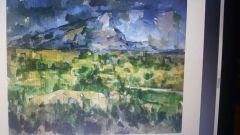
|
Paul Cezanne. Mount Saint Victoire above Tholonet Road. 1896-98. Post impressionism. Oil on canvas |
|
|
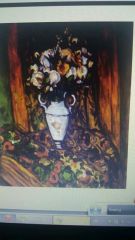
|
Paul Cezanne. Still Life with Flower Holder. 1903. Post impressionism. Oil on canvas |
|
|
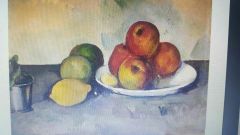
|
Paul Cezanne. Still Life with apples. 1880-1900. Post impressionism. Oil on canvas |
|
|
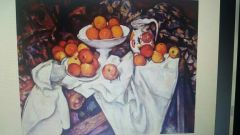
|
Paul Cezanne. Still Life with oranges. 1895-1900. Post impressionism. Oil on canvas |
|
|

|
Paul Cezanne. Still Life with Cupid. 1895. Post impressionism. Oil on canvas |
|
|
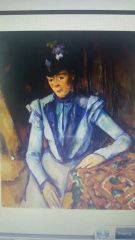
|
Paul Cezanne. Woman in blue. 1892-96. Post impressionism. Oil on canvas |
|
|
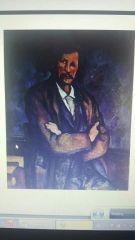
|
Paul Cezanne. Man with crossed arms. 1899. Post impressionism. Oil on canvas |
|
|
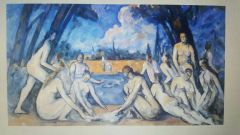
|
Paul Cezanne. The great bathers. 1898-1906. Post impressionism. Oil on canvas |
|
|
|
Art Nouveau |
Influenced by nature Reject mechanized world Dislike soulless machine production Favour re introduction of craft (arts and crafts) Bring art into functional life |
|
|
|
Pastiche |
Copying something that has already been done. |
|

